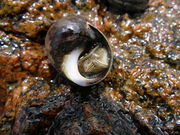Common periwinkle
| Common periwinkle | |
|---|---|
 |
|
| Periwinkle emerging from its shell, Sweden | |
| Scientific classification | |
| Kingdom: | Animalia |
| Phylum: | Mollusca |
| Class: | Gastropoda |
| (unranked): | clade Caenogastropoda clade Hypsogastropoda clade Littorinimorpha |
| Superfamily: | Littorinoidea |
| Family: | Littorinidae |
| Genus: | Littorina |
| Species: | Littorina littorea |
| Binomial name | |
| Littorina littorea (Linnaeus, 1758) |
|
The common periwinkle, winkle, or Littorina littorea, is a small edible species marine gastropod with gills and an operculum in the family Littorinidae.
This is an intertidal species with a dark and sometimes banded shell. It lives on shores in the North Atlantic Ocean.
Contents |
Shell

The shells range from 10 to 12 mm at maturity, with 30 mm being the upper limit.[1]
Distribution
Common periwinkles are native to the northeastern Atlantic Ocean, along the coasts of northern Spain, Scotland, Ireland, Scandinavia and Russia.
Introductions to North America
Common periwinkles have been introduced to the Atlantic coast of North America, possibly by rock ballast in the mid-19th century.[2]
The first recorded case was in 1840 in the Gulf of St. Lawrence.[2] It is now a predominant mollusc from New Jersey northward.
This species is also found on the West Coast of the United States, from California to Washington. The presence of this species has caused extensive damage due to interspecific competition with native intertidal gastropods.
Habitat

The common periwinkle is mainly found on rocky shores in the higher and middle intertidal zone. It sometimes lives in small tide pools. It may also be found in muddy habitats such as estuaries, and can reach depths of 60 m.
Life cycle
Females lay 10,000 to 100,000 eggs contained in a corneous capsule from which larvae escape and settle to the bottom. This species can breed year round depending on the local climate. It reaches maturity at 10 mm, and lives 5 to 10 years.
Feeding
The common periwinkle is primarily an algae grazer, but will feed on small invertebrates such as barnacle larvae. They use their radula to scrape algae from rocks, and, in the salt marsh community, pick up algae from the cord grass, or from the biofilm that covers the surface of mud in estuaries or bays.
Human use
This species appears in prehistoric shellfish middens throughout Europe, and is therefore known to have been an important source of food since at least 7,500 BC in Scotland[3]. It is still collected in huge quantities in Scotland, mostly for export to the Continent, and also consumed locally. The official landings figures for Scotland indicate that over 2,000 tonnes of winkles are exported annually. This makes winkles the sixth most important shellfish harvested in Scotland in terms of tonnage, and seventh most important in terms of value. However, since actual harvests are probably twice reported levels, the species may actually be the fourth and sixth most important, respectively[4].
They are usually picked off the rocks by hand or caught in a drag from a boat. They are eaten in Great Britain and Ireland where they are commonly referred to as winkles or in some areas willicks or wilks, and in Belgium where they are called crickles. They are commonly sold in paper bags near beaches in Ireland, salted and with a pin attached to the bag to assist extracting the soft parts from the shell.
Periwinkles are considered a delicacy in African and Asian cuisine. The meat is high in protein and low in fat; according to the USDA National Nutrient Database for Standard Reference, raw snails in general are about 80% water, 15% protein, and 1.4% fat.
Periwinkles are also used as bait for catching small fish. The shell is usually crushed and the soft parts extracted and put on a hook.
References
- ↑ Common periwinkle at marlin.ac.uk retrieved 16.10.2008
- ↑ 2.0 2.1 Chapman, J. W., J. T. Carlton, M. R. Bellinger, and A. M. H. Blakeslee. 2007. Premature refutation of a human-mediated marine species introduction: the case history of the marine snail Littorina littorea in the northwestern Atlantic. Biological Invasions 9:737-750.
- ↑ Ashmore, quoted in McKay and Fowler 1997 b
- ↑ McKay and Fowler 1997 b
- Abbott, R. Tucker, 1974. American Seashells. Second edition. Van Nostrand Rheinhold, New York
- Abbott, R. Tucker, 1986. Seashells of North America, St. Martin's Press, New York
This article incorporates public domain text (a public domain work of the United States Government) from:
- Amy Benson. 2008. Littorina littorea. USGS Nonindigenous Aquatic Species Database, Gainesville, FL. <http://nas.er.usgs.gov/queries/FactSheet.asp?speciesID=1009> Revision Date: 8/20/2007
External links
- Littorina littorea (mollusc) from the Invasive Species Specialist Group website of the World Conservation Union
- Common periwinkle from the Marine Life Information Network for Britain and Ireland
- Anatomy of the Periwinkle from a Lander University website
|
||||||||||||||||||||||||||||||||
|
|||||
